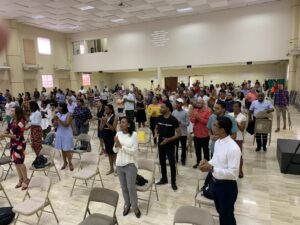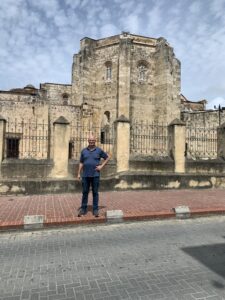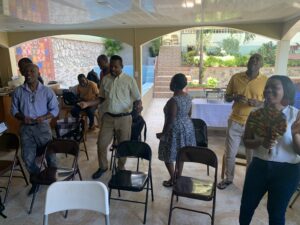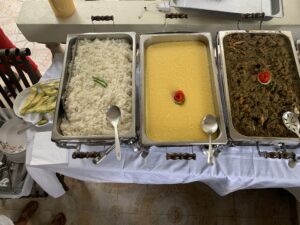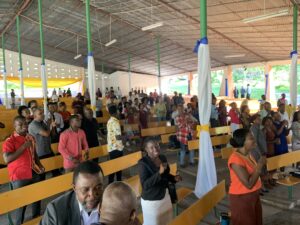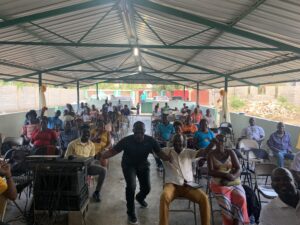Journal for Missionary Teaching Trip to Dominican Republic and Haiti
Missionary Teaching Trip to Dominican Republic and Haiti I Am now in Haiti. See below
Santo Domingo, Dominican Republic 8/7-8/11
This is only my second teaching trip to the Caribbean, and my first visit to either country. It is also my first overseas teaching venture in just under two and a half years due to the Covid pandemic. It feels great to get back to teaching the Bible to people around the world.
The Dominican Republic occupies the eastern two thirds of the island of Hispaniola. This is the first island occupied by the Spanish under Columbus in the 1490’s. There is a lot of history here, including the sad story of the wiping out of the local Taino people by the colonizers. The Dominican Republic has a population of 11 million, with five million of them in the capital, Santo Domingo. The city was founded in 1496, well over one hundred years before Jamestown. It is a politically stable country, with considerable poverty, but the people seem relatively content, especially with the much worse situation next door in Haiti. There is a “Don’t worry, be happy” feel here. One rather large issue for the local people is the mass migration of Haitians into their country. Of course, one can understand the desire to flee Haiti, but it does create disruption for the locals. Tourism is a major industry here, with Punta Cana being one of the favorite sites to enjoy the beautiful country. The beaches here are world-famous. And the local Caribbean food is amazing, with its emphasis on platanos, rice, beans and yucca.
Church in Santo Domingo
Our fellowship has four churches in this relatively small country, with six hundred members here in Santo Domingo, and a total of nine hundred in the country. The churches are led by Angel Martinez and his wife. They have two services on Sunday to allow for social distancing. Today I taught on the Christian Worldview and on the Reliability of the Bible, with a wonderful dinner of sanchocho, a kind of meat stew in between. I love it. Another local favorite is mangu, which is a plantain mash. I am not as sure about that dish. The fellowship was as great as the food.
On Monday I was blessed to visit the ancient colonial center of Santo Domingo. Lots of places claim to be the oldest of this or of that, but in this case, the claims are almost certainly true, as this was the very first European capital. We visited the first cathedral built in the New World. It was begun in 1511. We also visited the home of Diego Colon, the son of Cristobal Colon, known to Americans as Christopher Columbus. The home was begun in 1510. There is a wonderful Old World charm to this beautiful city. I am blessed to spend the day with a couple of campus students.
The oldest cathedral in the New World. Est. 1511
In the evening we had a class for the teens and campus on God and Science. The church here has had a relative lack of teaching, and they can use all the help they can get. For a strong Catholic country, there is a lot of skepticism and doubt about the Bible here. This is my favorite group wherever I go. There are about 50 teens and university students at the presentation, with great questions afterward. Very encouraging. Afterward, we have dinner of cachapas, which is like a corn pancake with cheese and pork in the center. Very good!
Tuesday included a trip to the oldest church in the New World. It is a small and simple building, built around 1496. It is amazing this building has lasted this long. Afterward, we travel to the Faro a Colon (lighthouse of Columbus), which is a massive mausoleum for Columbus, shaped like a cross, out of which a light so bright it can reportedly be seen from Puerto Rico emanates. We also visited a very large cenote (a subterranean pool) called Tres Ojos. For lunch we have Mafongo, which is mashed plantains with garlic and chicharones. In the evening is a talk on the existence of God for the singles.
Wednesday is my last day here. In the morning I am fortunate to spend some time swimming at one of the beautiful beaches near the capital. In the evening I teach on the Problem of Pain and suffering to the marrieds, with about two hundred present. I am feeling sad already as I prepare to leave. But first, a dinner of arepas.
Port au Prince, Haiti 8/11-8/14
Up at 4:00 AM for a flight to Port au Prince on Thursday. The flight is a real experience, as I am sitting in the front row of the plane, and, literally could touch the pilot on the shoulder without getting up from my seat. This would not fly (get it) in the US. I land in French-speaking Haiti. The culture here is so different, and the street scenes are different as well. The streets are busier and the atmosphere is more chaotic than the Dominican Republic. O the other hand, one sees so much laughter here. Much of what I see reminds me of Togo or Ivory Coast in Africa.
Staff in Haiti
Of course, this country is going through a heartbreaking time. After the death of 200,000 in the great earthquake of 2010, the country has experienced multiple disease outbreaks, coups, a second earthquake last year, and the assassination of their president in his own home last year as well. The church here is taking extraordinary security measures for me, as ¾ of the capital is now controlled by armed gangs, who appear to outgun the national police.
Yet, when I talk to my brother Jorel Claude, who traveled from Les Cayes in southwestern Haiti, I feel I am safer than anyone else here. Jorel , who leads our church in Les Cayes, told me that last week a Senator in the national government was stopped and murdered by criminal gangs on the same road he traveled to come here. He feared for his life coming to the classes, yet he came. I am both saddened and heartened by this brother’s heart to serve God.
Port au Prince, the capital of Haiti, has about 4 million of the twelve million inhabitants of the country. Haiti is the second oldest free nation in the Americas, having gained its freedom from France in 1804. The population is predominantly of African descent. Unfortunately, the nation has a tragic history of dictatorships, corruption and poor government in general, making it by far the poorest country in the Americas.
But then there are the churches here. There are eleven churches in our fellowship in Haiti, with over one thousand members. There is a mature leadership here, but they are unanimous in sharing that the ministry of teaching is way behind where it needs to be, which is why I am here. They are trying to establish a school of ministry, but are really struggling to know how to get it started. The churches here are led by Adler and Lynda Thimot. I was invited here by my friend Widler
I am whisked immediately to the home of Emile and Marieles Pantaleon. I will be staying here pretty much 24/7 for safety’s sake. Right away I am teaching on the Reliability of the Bible to the staff of 16 members throughout Haiti. I can hardly imagine how difficult it was for some to come. The books I brought to sell to the church are vacuumed up almost instantly. This church is very interested in growing in their faith. Food today includes salted cod, the traditional national dish of rice, goat meat and many kinds of fruit. One difficulty, at least for me, is that it is very hot and humid here. The home has air conditioning, but they only have electricity for six hours per day if they are really lucky, making it tough on a spoiled American like myself.
Friday included lessons for the staff on Church History and the Christian and Other Worldviews. Many questions resulted. Afterward, one of the brothers named Jerry had to spend the night at the home where the classes are happening because a murder took place on the road to his house today. This is the reality here. It is really hard. But, it meant we could have great fellowship together. Lunch included corn pudding, rice, of course, but also beans. But the beans here are a pureed liquid, with no actual individual beans. So different to me, but so tasty.
Church in Haiti
On Saturday I was finally able to leave the home to teach classes for the church here. The event is at a Nazarene retreat center. The building has a roof of corrugated iron, but no walls, which is good, because that way there is a breeze. I taught two classes from Hebrews, as well as one on the question of pain and suffering. It is so humbling to teach on this topic here in Haiti, because, unlike my Haitian friends, I am not very familiar with suffering. But, the lesson is much needed here. Dinner tonight includes lalo, which is a sort of national food. It is hard to describe—a little like spicy spinach.
Sunday is the highlight of my visit here. Church has about 250 present. I preached from Acts 20, which is Paul’s farewell address to the Ephesian elders. The service is very emotional, and the singing is amazing. It reminds me of Africa. People here dress very formal and very nice to church. It is almost like a fashion show. Again, this is like church in Africa. After church, I was finally able to get about the city just a bit, to go to a restaurant. The drive is 15 minutes through a warren of streets that are like a maze. The streets are VERY steep, and very narrow. You have to experience it, as it really cannot be described. But it is a wonderful experience. I feel that I am starting to figure out the Haitians. The odd thing is that this feels like one of the happiest countries, despite the tragedy. I find myself loving Haiti, and wanting to return.
Cap Haitien, Haiti 8/15-8/16
Early on Monday I fly to the second city of Haiti, which is Cap Haitien. This city of perhaps half a million is on the northern coast of the country. The flight is only about 25 minutes, over high mountains. Cap Haitien is a much safer place than the capital, but it is also very poor. It seems that most of the money in the country finds its way to the capital. People like living here because it is much safer and a more pleasant place to live, yet there is very little work here. Electrical power is very spotty here. In fact, it never did come on even once while I was here. The downtown area is a warren—a maze—of very narrow and unbelievably crowded streets. There is so much going on. In part, this is because today is a special holiday for the city. It is the festival of Notre Dame—our lady. Clearly this is a Catholic festival, but those who are not Catholic are more than willing to enjoy the festival.
Church in Cap Haitien
The city here has over two hundred members. It is ably led by Widler Charles and his wife. I am teaching on the role of the Holy Spirit in the Christian life, as well as on the doctrine of baptism. Such relatively basic subjects are important here. Pentecostal-style worship is very important here, and the members do not seem to fully understand why they do not join in such activities. I want to focus on the positives of how the Holy Spirit will help us in our spiritual lives, but the people come back to questions about why there are not people with miraculous gifts today. This is a necessary discussion. The class on baptism is similar, as people have been taught that the members of their fellowship are the only saved people. They struggle a lot to adjust to the idea that anyone who has put their faith in God, repented, made Jesus Lord and been baptized is saved—even if they are not part of the International Churches of Christ. Again, this is an important discussion. I am so encouraged by the deep and abiding faith of the members here. It is a challenge to a spoiled American Christian like myself.
Today Widler told me the story of his family moving to Cap Haitien eight months ago. They had been asked to lead the church here, but they lived in an area in Port au Prince which is fully controlled by the gangs. It was so dangerous that they decided to leave everything behind and to travel with just what they could carry. They left their car behind, because even driving it through the gang area was too dangerous. They arrived here, literally, with just what they could carry. No more. This challenges me to consider what I might be willing to do to serve God. My final day in Haiti I teach a class on finding Jesus in the Old Testament, as well as a two hour question and answer session. They have many concerns here about issues ranging from divorce and remarriage to what kinds of jewelry a Christian ought to wear. I explain to them that many of these questions are more for an elder/shepherd than a teacher, but do my best.
I leave Haiti with a heavy heart, as the situation for the disciples of Jesus here is so tough. I am inspired by their continued faithfulness to Jesus under such difficult circumstances. Please be praying for our churches in Haiti, and please consider coming here to encourage the churches, although you may want to wait until the political situation becomes a bit more stable. Also, please pray that, working with them, we can establish a school of ministry in the country. The drive to the airport to leave Cap Haitien was quite a harrowing experience, but thanks to my faithful helpers, I am off to my much safer and more comfortable home in the US.
John Oakes

